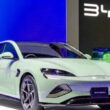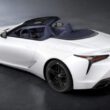Introducing the Exciting 2024 Ford Puma EV: A Deep Dive into Powertrain and Technical Marvels
Get ready to witness Ford’s electrifying leap into the all-electric small SUV domain with the eagerly anticipated Ford Puma EV. In the wake of Ford discontinuing the Fiesta from its lineup in 2023, the conventional internal combustion engine-powered Puma will continue to hold its ground as the brand’s smallest model.
However, the introduction of a pure-electric variant promises to broaden its appeal to a new generation of eco-conscious drivers.
The Puma EV is poised to join the prestigious ranks of Ford’s electric SUV family, which includes the acclaimed Mustang Mach-E and the recently unveiled VW ID.4-based Explorer. Notably, Ford is also set to introduce a Capri coupe-SUV with a cutting-edge all-electric powertrain, further cementing its commitment to electrification.
This thrilling move towards electrification is an integral part of Ford’s ambitious ‘Model e’ electrification plan, encompassing a lineup that includes four innovative new electric vans.

Among these electrifying offerings is the freshly unveiled E-Transit Courier, a van that shares the same pioneering B2E architecture found in the Puma. This common platform accommodates both internal combustion engines and full electrification, exemplifying Ford’s adaptability in catering to diverse customer needs.
While specific battery details for the E-Transit Courier and Puma EV remain undisclosed, what we do know is that the van boasts a formidable 134bhp/290Nm front-mounted electric motor, accompanied by a robust 100kW DC fast charging capability. We can reasonably anticipate this impressive charging capability to carry over to the Puma EV.
Ford’s extensive array of battery capacities includes options like 181bhp and 265bhp electric motors for larger models like the E-Transit, suggesting the potential for a range of powertrains in the Puma EV lineup.
With a 100kW fast charging system at its disposal, recharging the Puma EV promises to be a swift affair, offering the convenience of going from 10 to 80 percent battery capacity in under 35 minutes. Ford has also claimed a remarkable 54 miles of range can be added in just 10 minutes, making those pit stops a breeze.
Thanks to battery regeneration technology, one-pedal driving is within reach, enhancing both efficiency and driver convenience. When it comes to range, you can confidently expect over 200 miles on a single charge, ensuring that the Puma EV keeps you moving without constant charging concerns.
In terms of pricing, competitors like the Kia Soul EV, Peugeot e-2008, and Citroen e-C4 all hover around the £32,000 mark. Given this context, it’s reasonable to anticipate a similar price point for the eagerly awaited Puma EV when it hits the market next year.
As for the design, Ford enthusiasts can look forward to a familiar yet refreshed appearance, echoing the styling cues of the petrol-powered Puma. Ford has already teased us with a sneak peek of the Puma EV, and our exclusive render offers a comprehensive glimpse into the design.
While the electric variant maintains the standard car’s signature curvy crossover body shape, high-set headlights, and sloping rear end, expect a plethora of EV-specific enhancements. These include a sleek closed-off front grille, meticulously crafted LED running lights, and a subtly refined lower front bumper, all geared towards improving aerodynamic efficiency and visual appeal.
Production of the electric Puma will take place alongside Ford’s upcoming electric commercial vehicles at the state-of-the-art Ford Craiova factory in Romania. For Ford’s other electric SUV offerings—a mid-sized model and a sportier crossover—they will find their home at Ford’s Cologne plant, which is undergoing a transformation into an EV manufacturing hub thanks to a substantial £1.5 billion investment.
Unlike the Puma, these models will adopt Volkswagen’s MEB electric architecture as part of a ground-breaking technical partnership between the two automotive giants.
To complete the electric powertrain puzzle, Ford’s Halewood plant in Liverpool received a significant £380 million investment in December 2022, solidifying its role in producing the cutting-edge electric powertrains that will drive Ford’s electrified future.









